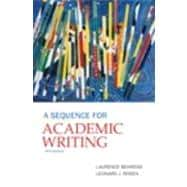
Note: Supplemental materials are not guaranteed with Rental or Used book purchases.
Purchase Benefits
Looking to rent a book? Rent A Sequence for Academic Writing [ISBN: 9780205172887] for the semester, quarter, and short term or search our site for other textbooks by Behrens, Laurence M.; Rosen, Leonard J.. Renting a textbook can save you up to 90% from the cost of buying.
Preface for Instructors
Note to the Student
Part One: Structures
Chapter 1—Summary, Paraphrase, and Quotation
What Is a Summary?
The Reading Process
How to Write Summaries
Will Your Job Be Exported?—Alan S. Blinder
Summarizing Figures and Tables
Paraphrase
Quotations
Avoiding Plagiarism
The Political Genius of Abraham Lincoln—Doris Kearns Goodwin
Chapter 2—Critical Reading and Critique
Critical Reading
The Moon We Left Behind Charles Krauthammer
Critique
Model Critique: A Critique of ”The Moon We Left Behind” by Charles Krauthammer—Andrew Harlan
The Common App Fallacy—Damon Beres
Chapter 3—Explanatory Synthesis
What Is a Synthesis?
Explanation: News Article from the New York Times
While Warning About Fat, U.S. Pushes Cheese Sales—Michael Moss
Argument: Op-Ed from the Boston Globe
Got Too Much Cheese?—Derrick Z. Jackson
How to Write Syntheses
The Explanatory Synthesis
The History of the Space Elevator—P. K. Aravind
Applications of the Space Elevator—Bradley C. Edwards
Going Up—Brad Lemley
Why We Need a Space Elevator—Cathy Swan and Peter Swan
Model Paper: The Space Elevator—Sheldon Kearney
Chapter 4—Argument Synthesis
What Is an Argument Synthesis?
Demonstration: Developing an Argument Synthesis—Balancing Privacy and Safety in the Wake of Virginia Tech
Mass Shootings at Virginia Tech: Report of the Review Panel
Laws Limit Schools Even After Alarms—Jeff Gammage and Stacey Burling
Perilous Privacy at Virginia Tech—Christian Science Monitor
Colleges Are Watching Troubled Students—Jeffrey McMurray
Campus Stabbing Student Sues UC Regents—Larry Gordon
Virginia Tech Massacre Has Altered Campus Mental Health Systems—Associated Press
The Family Educational Rights and Privacy Act (FERPA)
Model Argument Synthesis: Balancing Privacy and Safety in the Wake of Virginia Tech—David Harrison
Developing and Organizing the Support for Your Arguments
The Comparison-and-Contrast Synthesis
Model Exam Response: Key Similarities and Differences between World Wars I and II
Summary of Synthesis Chapters
Chapter 5—Analysis
What Is an Analysis?
How to Write Analyses
The Plug-In Drug—Marie Winn
When Your Perspective Guides the Analysis
Model Analysis: The Case of the Missing Kidney Linda Shanker
A Theory of Human Motivation—Abraham H. Maslow
The Appeal of the Democracy of Goods—Roland Marchand
Elements of an Effective Layout—Dorothy Cohen
Part Two: Strategies
Chapter 6—Writing as a Process
Writing as Thinking
Stages of the Writing Process
Stage 1: Understanding the Task
Stage 2: Gathering Data
Stage 3: Invention
Stage 4: Drafting
Stage 5: Revision
Stage 6: Editing
Chapter 7- Locating, Mining, and Citing Sources
Source-Based Papers
Preliminary Research
Focused Research
The Working Bibliography
Arrainging Your Notes: The Outline
Plagiarism, the Internet, and Fair Use
MLA Style: In-text Citations
MLA Style: Citations in the Works Cited List
APA Style: In-text Citations
APA Style: Citations in the References List
Chapter 8- Practicing Academic Writing
The Changing Landscape of Work in the Twenty-first Century
Work and Workers in the Twenty-first Century- Richard Judy and Carol D'Amico
The Untouchables- Thomas Friedman
Will Your Job Be Exporter?- Alan Blinder
Into the Unknown- The Economist
Employment Projections: 2006-2016 Summary- The Bureau of Labor Statistics
Engineering- Victoria Reitz
Business- Tom Peters
Technology and Services- Steve Lohr
Law- Tom McGrath
Medicine- Matt Richtel
Credits
Index
The New copy of this book will include any supplemental materials advertised. Please check the title of the book to determine if it should include any access cards, study guides, lab manuals, CDs, etc.
The Used, Rental and eBook copies of this book are not guaranteed to include any supplemental materials. Typically, only the book itself is included. This is true even if the title states it includes any access cards, study guides, lab manuals, CDs, etc.